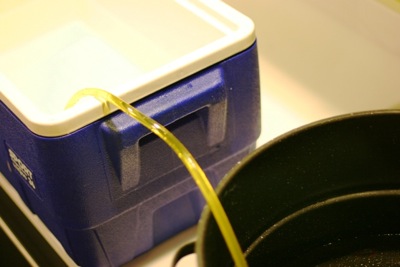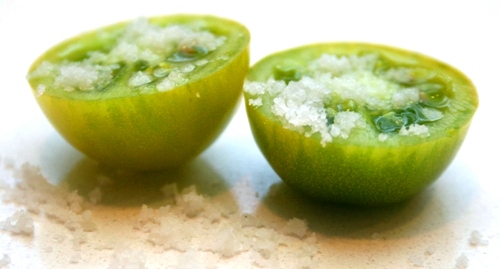 Linda’s newfangled saltwater storing device, aka a standard rectangular cooler.Back in the days when my husband and I were blissful DINK’s (double income no kids), I collected shoes. Whether we were in Tijuana, Mauritius, or the far-reaches of Eastern Romania, I’d shove my feet in the nearest pair — the weirder the better. After we acquired a height-of-the-market mortgage and had a son with a shoe habit that rivals his mommy’s, I had to switch to my backup plan: collecting salt.
Linda’s newfangled saltwater storing device, aka a standard rectangular cooler.Back in the days when my husband and I were blissful DINK’s (double income no kids), I collected shoes. Whether we were in Tijuana, Mauritius, or the far-reaches of Eastern Romania, I’d shove my feet in the nearest pair — the weirder the better. After we acquired a height-of-the-market mortgage and had a son with a shoe habit that rivals his mommy’s, I had to switch to my backup plan: collecting salt.
In Hawaii there was the red alaea, which is coarse-ground and tastes of clay. In Sicily there was sea salt collected in pans and flavored by the coral in the water, and in St. Barts the splendor of a large salt pond rivalled that of the turquoise Caribbean waters. Soon, I had amassed a stockpile of more than 30 salts from around the world. My only rule was I had to have visited the source.
Then the salt-craze hit the U.S., and stores like Portland, Ore.’s The Meadow cropped up, selling hundreds of salts from far-flung locales. Even my local Whole Foods now carries over 15 types of salt. When my global collection became less rare, I began harvesting small amounts of seawater when I traveled. If we rented a condo, I’d use a combination of sunshine and stovetop evaporation to make salt from the nearest shore. I learned that salt from Puerta Vallarta tastes like jet-ski fuel, whereas salt from Victoria, B.C. was delicate, like the lips of a mermaid. Soon, I had a major case of the salt-harvesting bug.
Below are some tips to get started yourself.
- Find a spot where the water is clean enough to collect. Through a combination of trial-and-error and studying pollution patterns, I discovered my personal collection spot in the vicinity of Deception Pass, Wash., not far from Seattle. Always gather from an area that is also legal and safe. High winds, blustery rain storms, and electric fences on naval bases are all red flags I’ve ignored. Learn from my mistakes! Calm, dry days on desolate shores make for easy seawater-gathering.
 You’ll need a lot of water. The rule of thumb: about five gallons of seawater yields four cups of salt, but not all seawater is equally salty, and recent rain showers can skew the ratio. On the other hand, a little bit of the finished product goes a long way and there is no replicating the gleam in a food lover’s eye when you hand them a hard-earned vial of homemade salt.
You’ll need a lot of water. The rule of thumb: about five gallons of seawater yields four cups of salt, but not all seawater is equally salty, and recent rain showers can skew the ratio. On the other hand, a little bit of the finished product goes a long way and there is no replicating the gleam in a food lover’s eye when you hand them a hard-earned vial of homemade salt.
- Gather water with medium-sized, rectangular coolers. Round water coolers are buoyant and difficult to fill with water, and five-gallon water jugs don’t have a big enough mouth to make the gathering effective. To avoid silt, it’s a good idea to walk out into the surf as far as your constitution will allow. Better yet, collect by boat.
- Let it sit. After you’ve schlepped your water home, rack it, just like wine, for a few days. Leave the cooler untouched in a cool place, so that all the sediment and salt particles sink to the bottom. Then, siphon the clean water into a large cauldron. I use a canning pot. Do not siphon the bottom inch or so, as that contains impure sediment. Place the cauldron over low heat on the stovetop. The water should ideally never go over 170 degrees F, and whatever you do, don’t boil it.
 Patience is key. A five-gallon batch may take a day or two to evaporate, but keep an eye on it. Once the water level drops to a few inches, crystals will start to form. At this point, I like to remove the pot from heat and carefully (so as not to compromise the crystal structure) pour the water into a wide, shallow pan. If it’s sunny enough, I will do the final evaporation in my light-filled window box. In winter, I’ll put it in the oven on the lowest setting, stirring gently every once in a while. This method produces great crystals. I resist over-evaporation because it weakens the flavor. Instead, I let the last of the water drip out of the salt by placing it in a tamis (ideally) or shallow sieve for a few days.
Patience is key. A five-gallon batch may take a day or two to evaporate, but keep an eye on it. Once the water level drops to a few inches, crystals will start to form. At this point, I like to remove the pot from heat and carefully (so as not to compromise the crystal structure) pour the water into a wide, shallow pan. If it’s sunny enough, I will do the final evaporation in my light-filled window box. In winter, I’ll put it in the oven on the lowest setting, stirring gently every once in a while. This method produces great crystals. I resist over-evaporation because it weakens the flavor. Instead, I let the last of the water drip out of the salt by placing it in a tamis (ideally) or shallow sieve for a few days.
- Use it carefully. I guarantee you won’t find barrels of these salts in the kitchens of high-end restaurants across the country, because most chefs use Diamond Crystal Kosher salt for the majority of their cooking needs. Fine salts are meant for finishing: They’re dusted on at the very end of the process. A little bit goes a long way, and different salts complement different foods. Don’t believe me? Host a salt-tasting soiree and see for yourself.
Salt-making is an addictive adventure, but the reward is great. I always make more than I think I’ll need because news of a fresh harvest travels fast among my friends and colleagues. Take advantage of the waning good weather and head to the seashore before it’s so cold you freeze your thighs off. You won’t regret it.



